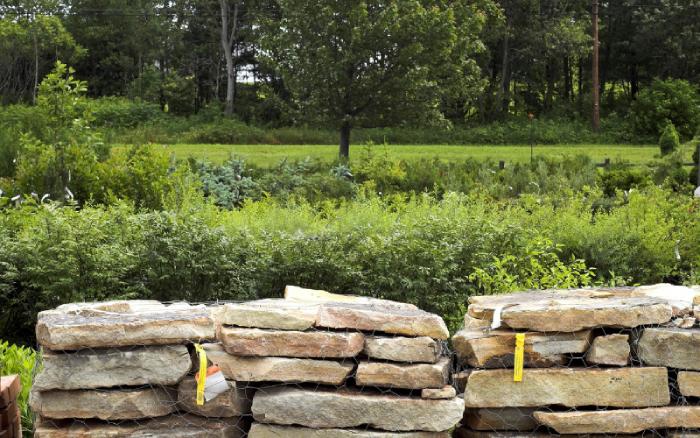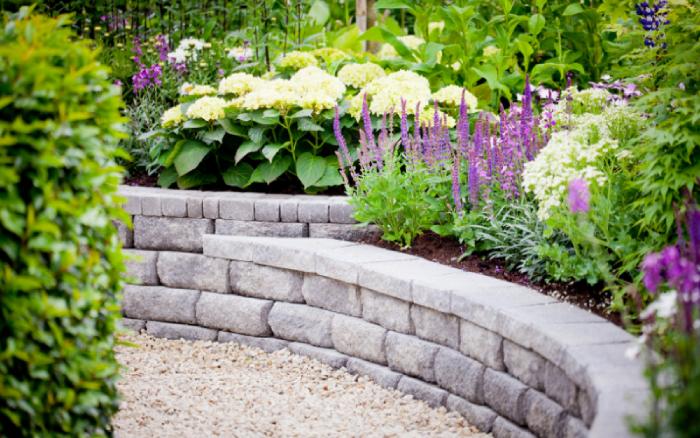Creating a beautiful, functional outdoor space starts with selecting the right materials for hardscaping. Choosing the best materials can transform your yard, giving it the durability and style to withstand daily use and changing weather. Each material option—from natural stone to concrete pavers—offers unique benefits that suit different design goals and environmental conditions.
In this guide, you’ll find insights to help you make informed choices for a lasting, low-maintenance hardscape installation that complements your vision. By exploring these options, you can achieve a cohesive, practical design that enhances your outdoor space’s appeal and longevity.
Common Materials for Hardscaping
There are numerous options to choose from when it comes to hardscaping materials, each bringing its own aesthetic appeal and functionality to outdoor spaces. Whether you’re aiming for durability, texture, or a specific style, here’s a list of popular choices:
- Natural stone
- Concrete pavers
- Brick
- Gravel
- Wood
- Decomposed granite
- Flagstone
- Porcelain tiles
- Sand
- Limestone
Tips to Select the Right Materials for Hardscaping
When selecting materials for your hardscaping project, there are numerous factors to consider to ensure durability, style, and functionality. The right materials can enhance your outdoor space’s appearance and longevity, making it both inviting and practical. Below are some essential tips to guide you in choosing the best hardscaping materials for your needs.
1. Consider Climate Compatibility
Opt for materials that withstand your local climate. For instance, in colder regions, materials like natural stone or concrete pavers resist frost and temperature fluctuations better. In warmer climates, lighter-colored stones or composite materials can prevent excessive heat absorption, making the space comfortable. Climate-resistant materials help maintain durability, reduce maintenance, and ensure your hardscape withstands seasonal weather changes, ensuring it looks beautiful year-round with minimal upkeep.
2. Match Material with Aesthetic Goals
Choose materials that align with your desired design aesthetic. Natural stones like limestone and slate work well for a rustic look, while modern spaces benefit from concrete pavers and porcelain tiles. Consider color, texture, and shape to create visual harmony. Matching your material with the aesthetic style of your home and landscape will create a cohesive outdoor look that complements your surroundings and personal taste.
3. Prioritize Durability and Maintenance
Assess how much time and effort you’re willing to invest in maintenance. Some materials, like brick, require regular upkeep, while others, such as concrete, need less. Granite and sandstone offer a low-maintenance option for patios, and concrete pavers are easy to clean and repair. Durable, low-maintenance materials can save time and cost in the long run, ensuring your hardscaping remains attractive and functional with minimal effort.
4. Evaluate Slip Resistance for Safety
Opt for slip-resistant materials, especially around water features or patios. Textured stones, such as travertine and flagstone, offer added grip, reducing the risk of slipping when surfaces are wet. Pavers with rough finishes or anti-slip coatings are ideal for areas prone to moisture. Prioritizing slip resistance enhances safety, particularly in high-traffic areas or regions with heavy rainfall, ensuring peace of mind for family and guests.
5. Factor in Budget Constraints
Consider your budget, as costs vary significantly among materials. While concrete is budget-friendly, natural stones like bluestone or granite can be pricier. Evaluate each material’s upfront cost, installation fees, and maintenance expenses. Balancing quality with affordability ensures you choose hardscaping materials that fit your budget without compromising on aesthetics or durability, allowing you to achieve your vision within financial constraints.
6. Think About Sustainability
If eco-friendliness is a priority, opt for sustainable materials like permeable pavers or recycled stones, which allow water to seep through, reducing runoff and erosion. Other sustainable options include reclaimed wood or natural stone sourced locally to reduce environmental impact. By choosing eco-friendly materials, you contribute to environmental conservation and create a natural, harmonious outdoor space that aligns with sustainable practices.
7. Plan for Long-Term Usability
Consider how your outdoor space might evolve over time. Choose versatile materials that accommodate potential expansions or repurposing, such as adjustable pavers or modular stones. Durable materials like concrete and stone can withstand repurposing while ensuring consistent quality over years of use. Planning with long-term flexibility in mind allows your hardscaping to adapt to future changes, providing functional and aesthetic appeal for years.

Frequently Asked Questions
Low-maintenance materials for hardscaping include concrete, decomposed granite, and durable natural stones like slate or sandstone. These options resist weathering, require minimal cleaning, and maintain their appearance over time, making them ideal for those seeking an attractive outdoor space with limited upkeep. Concrete pavers, in particular, are easy to clean and repair if needed.
Yes, permeable materials like gravel and decomposed granite help reduce erosion by allowing water to pass through instead of running off. These eco-friendly options support soil stability and prevent erosion, particularly in sloped areas, creating a more stable and sustainable landscape.
Yes, materials like natural stone and concrete pavers perform well in colder climates, as they resist cracking from freeze-thaw cycles. Avoid porous materials that can absorb water and freeze, as this can cause damage. Choosing climate-resistant materials ensures your hardscape remains durable and beautiful year-round.
Conclusion
Selecting the best materials for hardscaping can elevate both the durability and style of your outdoor space, providing a lasting landscape that withstands the test of time. By considering climate compatibility, aesthetics, and sustainability, you create a practical and beautiful environment. With the right materials, your yard becomes a low-maintenance, inviting space to enjoy for years.
Ready to enhance your outdoor space? Contact us at Audet Enterprises for expert hardscape installation in Portland, Maine, and discover the materials that best fit your vision and landscape needs. Transform your yard into a functional, beautiful retreat with our trusted team.
⬇️ Find us on Google Maps: Yard Cleanup Services in Portland, Maine ⬇️


